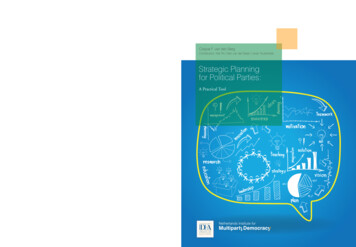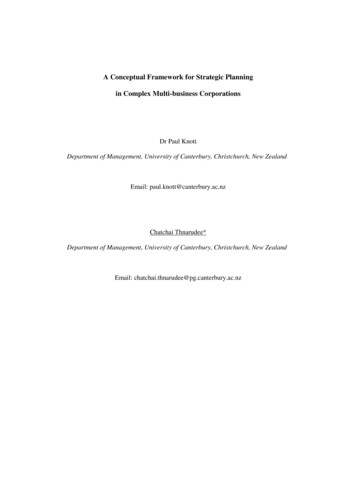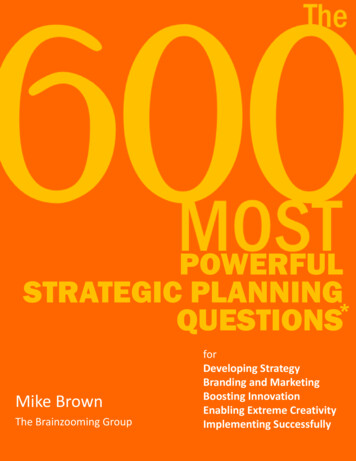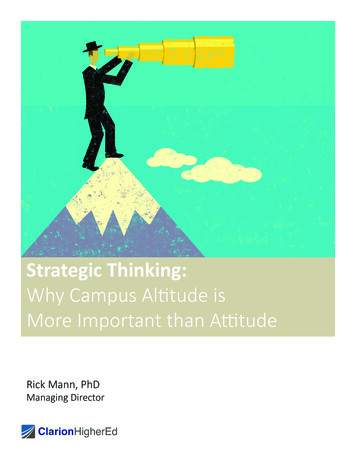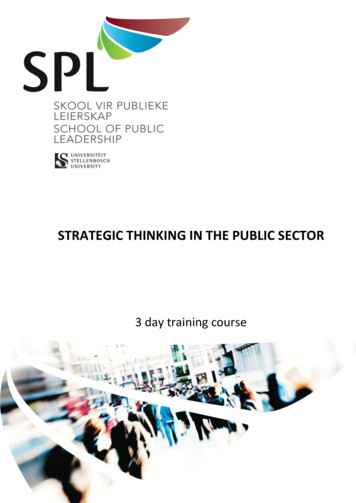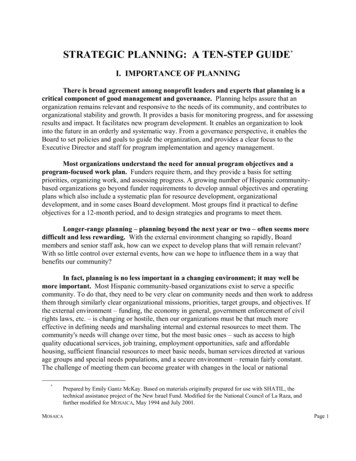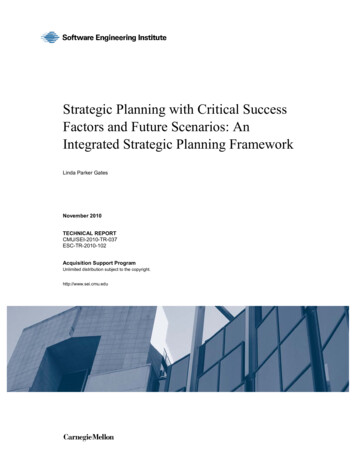
Transcription
Strategic Planning with Critical SuccessFactors and Future Scenarios: AnIntegrated Strategic Planning FrameworkLinda Parker GatesNovember 2010TECHNICAL n Support ProgramUnlimited distribution subject to the copyright.http://www.sei.cmu.edu
This report was prepared for theSEI Administrative AgentESC/XPK5 Eglin StreetHanscom AFB, MA 01731-2100The ideas and findings in this report should not be construed as an official DoD position. It is published in theinterest of scientific and technical information exchange.This work is sponsored by the U.S. Department of Defense. The Software Engineering Institute is a federallyfunded research and development center sponsored by the U.S. Department of Defense.Copyright 2010 Carnegie Mellon University.NO WARRANTYTHIS CARNEGIE MELLON UNIVERSITY AND SOFTWARE ENGINEERING INSTITUTE MATERIAL ISFURNISHED ON AN “AS-IS” BASIS. CARNEGIE MELLON UNIVERSITY MAKES NO WARRANTIES OFANY KIND, EITHER EXPRESSED OR IMPLIED, AS TO ANY MATTER INCLUDING, BUT NOT LIMITEDTO, WARRANTY OF FITNESS FOR PURPOSE OR MERCHANTABILITY, EXCLUSIVITY, OR RESULTSOBTAINED FROM USE OF THE MATERIAL. CARNEGIE MELLON UNIVERSITY DOES NOT MAKEANY WARRANTY OF ANY KIND WITH RESPECT TO FREEDOM FROM PATENT, TRADEMARK, ORCOPYRIGHT INFRINGEMENT.Use of any trademarks in this report is not intended in any way to infringe on the rights of the trademark holder.Internal use. Permission to reproduce this document and to prepare derivative works from this document for internal use is granted, provided the copyright and “No Warranty” statements are included with all reproductions andderivative works.External use. This document may be reproduced in its entirety, without modification, and freely distributed inwritten or electronic form without requesting formal permission. Permission is required for any other externaland/or commercial use. Requests for permission should be directed to the Software Engineering Institute atpermission@sei.cmu.edu.This work was created in the performance of Federal Government Contract Number FA8721-05-C-0003 withCarnegie Mellon University for the operation of the Software Engineering Institute, a federally funded researchand development center. The Government of the United States has a royalty-free government-purpose license touse, duplicate, or disclose the work, in whole or in part and in any manner, and to have or permit others to do so,for government purposes pursuant to the copyright license under the clause at 252.227-7013.For information about SEI publications, please visit the library on the SEI website (www.sei.cmu.edu/library/).
Table of ContentsPrefaceviiAcknowledgementsixExecutive SummaryxiAbstractxiii1Introduction1.1 Purpose and Structure of this Report1.2 Background1.3 The Strategic Planning Landscape11112Strategic Planning2.1 Strategic Planning2.2 Strategic Planning Elements2.3 Strategic Planning and Organizational Hierarchy33463Critical Success Factors3.1 Critical Success Factors3.2 CSF Characteristics3.3 The Critical Success Factor Method999114Future Scenarios4.1 Future Scenarios4.2 The Future Scenario Method4.3 General Limitations of Scenario Planning131313195Integrating Critical Success Factors and Future Scenarios with Strategic Planning5.1 Strategic Thinking5.2 The Strategy Paradox5.3 Integrating Critical Success Factors and Future Scenarios with Strategic Planning5.4 Linking CSFs and Scenarios21212223306Special Considerations for IT Strategy6.1 IT Strategic Planning6.2 IT Critical Success Factors6.3 IT Future Scenarios313132347Conclusions7.1 Applicability7.2 Limitations7.3 Future Work35353636Appendix ACSF Method Application Notes39Appendix BScenario Planning Application Notes43Appendix CGlossary45References47SOFTWARE ENGINEERING INSTITUTE i
SOFTWARE ENGINEERING INSTITUTE ii
List of FiguresFigure 1:Typical Strategic Planning Elements4Figure 2:Critical Success Factor Hierarchy10Figure 3:Example Driving Forces for Government Health Care14Figure 4:Example Critical Uncertainties for Government Health Care15Figure 5:Example Government Health Care Scenario Matrix16Figure 6:Example Government Health Care Scenarios with Narrative Titles17Figure 7:Example Government Health Care Scenarios with Implications18Figure 8:The Strategic Process: Strategic Planning and Strategic Thinking22Figure 9:Critical Success Factors and Future Scenarios with Typical Strategic Planning Elements 24Figure 10:Critical Success Factor Levels and Strategic Planning26Figure 11:CSF Relationships with Strategic Planning Elements27Figure 12:Future Scenario Relationships with Other Strategic Planning Elements29Figure 13:Context for IT Strategy32Figure 14:Critical Success Factors and IT Strategy34Figure 15:Future Scenarios and IT Strategy34Figure 16:Enhanced Strategic Planning in Context35SOFTWARE ENGINEERING INSTITUTE iii
SOFTWARE ENGINEERING INSTITUTE iv
List of TablesTable 1:Strategic Planning Terms5Table 2:Parsons/Thompson Model of Organizational Structure7SOFTWARE ENGINEERING INSTITUTE v
SOFTWARE ENGINEERING INSTITUTE vi
PrefaceThis report explores the value of enhancing typical strategic planning techniques with the criticalsuccess factor (CSF) method and scenario-based planning and presents an integrated frameworkfor strategic planning. Strategic planning, CSFs, and scenario planning all require expertise in theparticular method. Expertise in the domain where the techniques will be applied (e.g., organizational strategy, information technology [IT] strategy, security management) is also advised.Although this report describes insights gained from recent work with CSFs, scenarios, and strategic planning, the experiences described in this report derive from limited engagements and therefore cannot be fully generalized. However, the conclusions presented here reflect insights that willbe useful in subsequent efforts to integrate CSFs and scenarios with strategic planning efforts andfurther validate the information framework.SOFTWARE ENGINEERING INSTITUTE vii
SOFTWARE ENGINEERING INSTITUTE viii
AcknowledgementsMany people contributed to this report by supporting the work that led to it. Those people includeRita Creel, Eileen Forrester, Mark Kasunic, Bill Novak, Steve Palmquist, Kate Ambrose Sereno,Gian Wemyss, and David White.I would like to acknowledge the excellent research assistance provided by Sheila Rosenthal. I amvery thankful for the astute comments offered by my reviewers: Rich Caralli, Bill Novak, StevePalmquist, and Mary Catherine Ward. I greatly appreciate the technical editing provided by BillThomas and Murray Connelly.Finally, I would like to thank the Carnegie Mellon Software Engineering Institute (SEI) and thesponsors of this work: Bill Novak, Tricia Oberndorf, Steve Palmquist, Terry Roberts, and MaryCatherine Ward. Carnegie Mellon is registered in the U.S. Patent and Trademark Office by Carnegie Mellon University.SOFTWARE ENGINEERING INSTITUTE ix
SOFTWARE ENGINEERING INSTITUTE x
Executive SummaryAlthough the purpose of strategic planning is straightforward—to outline where an organizationwants to go and how it’s going to get there—its nature is complex and dynamic. Two techniques,the critical success factor (CSF) method and future scenario planning, can augment strategic planning efforts by illuminating an organization’s present situation and potential future. This reportexplores the value of enhancing typical strategic planning techniques with the CSF method andscenario-based planning and presents an integrated framework for helping organizations understand the broad range of interrelated elements that influence strategy development.Critical success factors are defined as the handful of key areas where an organization must perform well on a consistent basis to achieve its mission. CSFs can be derived through a documentreview and analysis of the goals and objectives of key management personnel, as well as interviews with those individuals about their specific domain and the barriers they encounter inachieving their goals and objectives.Future scenarios allow organizations to explore multiple potential futures and generate robuststrategies and early warning signs to understand how the future is unfolding. Where a vision articulates a “preferred future,” future scenarios describe how an organization might achieve its mission in different circumstances or environments. Organizations identify a focal issue or major decision the organization faces and the critical uncertainties in the macro environment, such associal, economic, political, environmental, and technical forces. Scenarios are developed based oncombinations of these forces and robust strategies are identified to address multiple futures. Finally, indicators are identified to help understand how the future is affecting the organization’s decisions.The Carnegie Mellon Software Engineering Institute (SEI) began exploring the synergy betweenCSFs and future scenarios in the strategic planning context in 2005 and has assisted several organizations in using an integrated framework over the past four years. The report synthesizes documented theory and research in strategic planning, CSFs, and scenarios and provides insights andlessons regarding the value and limitations of the integrated strategic planning framework. Thereport includes considerations for applying this approach in the context of strategic planning forinformation technology.Suggestions for future work include exploring the use of IT or security scenarios in unit-level planning and organizational strategic planning creating an integrated strategic planning process to support the integrated farmework connecting CSFs and scenarios directly to one another in the monitoring stages of an integrated strategic planning process. Carnegie Mellon is registered in the U.S. Patent and Trademark Office by Carnegie Mellon University.SOFTWARE ENGINEERING INSTITUTE xi
Two appendices provide notes from the SEI’s experience applying the CSF method and scenarioplanning in the context of strategic planning.SOFTWARE ENGINEERING INSTITUTE xii
AbstractThis report explores the value of enhancing typical strategic planning techniques with the criticalsuccess factor (CSF) method and scenario planning. It synthesizes documented theory and research in strategic planning, CSFs, and future scenarios. It proposes an enhanced, integrated information framework for strategic planning that can help organizations understand the broadrange of interrelated elements that influence strategy development. Finally, the report providesinsights and lessons regarding the value and limitations of the integrated strategic planningframework and suggestions for future work.SOFTWARE ENGINEERING INSTITUTE xiii
SOFTWARE ENGINEERING INSTITUTE xiv
1 IntroductionIndustry executives and analysts often mistakenly talk about strategy as if it were somekind of chess match. But in chess, you have just two opponents, each with identical resources, and with luck playing a minimal role. The real world is much more like a pokergame, with multiple players trying to make the best of whatever hand fortune has dealtthem.—David Moschella11.1Purpose and Structure of this ReportThis report explores the value of enhancing typical strategic planning with the critical successfactor (CSF) method and future scenarios. It synthesizes documented theory and research in strategic planning, CSFs, and future scenarios, and proposes an information framework for enhancedstrategic planning.This report does not advocate or articulate a specific strategic planning approach, though theoriesare discussed and pointers to published methods are provided. Nor does the report document theCSF and scenario planning methods; these methodologies are published elsewhere.21.2BackgroundIn 2005, the SEI began exploring the idea of pairing the CSF method with future scenarios in astrategic planning context. The SEI had previously used these techniques independently of oneanother in multiple engagements.3In 2006 the SEI created an initial framework for integrating the information generated by thesetwo techniques with information typically required for strategic planning. The initial pilot resultedin the development of a 10-year information technology (IT) strategic plan. Additional pilots havebeen conducted using pieces of the framework to develop one- to five-year organizational strategic plans.1.3The Strategic Planning LandscapeStrategic plans outline an organization’s intended approach for achieving its mission. There aremany ways to conduct strategic planning, most of which result in a plan or set of plans that articulate organizational goals and a high-level strategy for achieving them.1Moschella, David. “Ten Key IT Challenges for the Next 20 Years,” Computerworld, December 1999.2The CSF method is documented in a report by Richard Caralli; the future scenario method is described in Scenarios: The Art of Strategic Conversation [Caralli 2004, van der Heijden 1996].3Scenario planning exercises were led by Global Business Network (GBN).SOFTWARE ENGINEERING INSTITUTE 1
CSFs and future scenarios both have extensive histories with operational and strategic planning.The CSF method results in an identified set of organizational critical success factors that representkey performance areas that are essential for the organization to accomplish its mission. Scenarioplanning explores multiple potential futures and generates multiple robust strategies (not completestrategic plans) and a set of early-warning signs that help an organization understand how the future is unfolding. In addition, both CSFs and scenarios provide processes that help an organizationestablish strong ways of thinking, communicating, and making decisions. Neither method, however, constitutes a strategic planning effort, results in a strategy or strategic plan per se, or has adirect, explicit interface with strategic planning.SOFTWARE ENGINEERING INSTITUTE 2
2 Strategic PlanningIn strategy it is important to see distant things as if they were close and to take a distancedview of close things.—Miyamoto Musashi, samurai warrior42.1Strategic PlanningStrategic planning is the process of defining an organization’s plans for achieving its mission. Anorganizational strategy is a derived approach to achieving that mission. The product of a strategicplanning effort is typically a document (a strategic plan) that elaborates a high-level strategy andarticulates the elements that influence it—it is a full description of the organizational environmentand intentions. Note that a strategy is directional in nature; although descriptions and analysis ofthe present situation are included, a strategic plan does not merely endorse the status quo, it directs change of some kind [Cassidy 2006]. Division-level and organizational-unit-level planningshould be tied directly to the organization’s strategic plan.Strategic planning is not only an important foundation for executing work; it also sets the stagefor enterprise architecture, process improvement, risk management, portfolio management, andany other enterprise-wide initiatives.There are many documented approaches to strategic planning.5 Typical strategic planningprocesses examine an organization’s current environment and abilities (the present situation),considerations about how it would like to grow or evolve (the desired future), its aspirations as anorganization (what it will strive to do), and its intentions for moving forward (how it will moveforward). These high-level elements are described below: The What: These are descriptions of what the organization does and what it aspires toachieve—its organizational targets—including its goals, objectives, and quantitative performance measures. The Present: The present situation, or current environment, is typically described in terms ofthe organization’s mission, guiding principles (or values), organizational strengths (or enablers), and organizational barriers (weaknesses or challenges). The Future: The desired future is described by the organizational vision and targets. The How: The preferred route to achieving the organizational goals, objectives, and missionis communicated as a strategy or as strategic goals.64Musashi, Miyamoto. The Book of Five Rings: Classic Treaty on Military Strategy. Wildside Press, 2009.5One good example is the 1994 book Team-Based Strategic Planning: A Complete Guide to Structuring, Facilitating, and Implementing the Process by David Fogg [Fogg 1994].6Strategic goals typically reflect the primary goals of an organization or enterprise and imply a particular set ofstrategies.SOFTWARE ENGINEERING INSTITUTE 3
Figure 1 shows the typical strategic plan elements and their relationships to one another.Figure 1:Typical Strategic Planning ElementsNote that goals and the steps to achieving them (i.e., the whats and hows) can take on a differenttenor at different hierarchical levels of an organization. For example, an organizational strategymight serve as a set of goals for managerial staff, for which that staff will create a sub-strategy;that sub-strategy might translate into goals for technical or production staff.2.2Strategic Planning ElementsA well-documented strategic plan is critically important for organizing thinking and communicating thoughts. Strategic plans include elements that describe an organization’s present state, aspirations, intentions for the future, and approach for going forward.Table 1 contains the definitions of the terms typically used to describe strategic planning elements(see also Figure 1). Understanding these elements and their relationship to one another supportsnot only strategic thinking and planning, but also the effective use of CSFs and future scenarios instrategic planning efforts.SOFTWARE ENGINEERING INSTITUTE 4
Table 1:Strategic Planning TermsTermDefinitionMissionAn organization’s mission is its primary business or purpose; it describes what an organization does, for whom, and its benefit. The mission of an organization is not a time-bound objective.VisionA vision is an ideal that an organization intends to pursue. It links the organization to the future by articulating instantiations of successful execution of the mission. An organization’svision is a source of inspiration and can be broader than the organization’s capabilities. Itmight, in fact, describe what can be achieved in a broader environment if the organization andothers are successful in achieving their individual missions.GoalsGoals are broad, measurable, aims that support the accomplishment of a mission.ObjectivesObjectives are specific, quantifiable, lower-level targets that indicate an accomplishment of agoal.GuidingPrinciplesGuiding principles are directive statements that articulate the constraints an organizationchooses to place upon the way it achieves its goals. Guiding principles embrace core valuesand are used to shape an organization’s strategy. Guiding principles reflect long-term intentions, but are not necessarily permanent.7EnablersEnablers are external conditions or organizational strengths that facilitate an organization’sability to accomplish its goals or objectives.BarriersBarriers are external conditions or organizational (internal) weaknesses that hinder an organization’s ability to accomplish a goal or objective.StrategyA strategy is a derived approach to achieving the mission, goals, and objectives of an organization. It supports the organizational vision, takes into account organizational enablers andbarriers, and upholds its guiding principles.Strategic PlanA strategic plan is a document that results from a strategic planning activity. It elaborates theorganizational strategy and documents the elements that influence it.InitiativeAn initiative is a specific set of actions that implement a strategy.ActionsActions are specific steps to achieve a goal or objective. Actions typically have assigned staffand schedule constraints.PerformanceMeasuresPerformance measures describe performance targets relevant to each objective.7A guiding principle may seem similar in content to a goal but it lacks measurable aims. A guiding principle cangenerate a goal when an organization chooses to commit resources to achieving a measurable result regardingits content.SOFTWARE ENGINEERING INSTITUTE 5
As a partial example, consider the mission statement of the United States Postal Service (USPS)from its five-year strategic plan for fiscal years 2001–2005: “To bind the nation together throughthe correspondence of the people, to provide access in all communities, and to offer prompt, reliable postal services at uniform prices.” In its vision statement, the USPS sought “to become anorganization that can improve performance and affordability, implement innovative ways to growboth its revenues and those of the mailing industry, and find flexible, responsive solutions to thechallenges raised by technology and the seismic shifts in the global postal business environment.”This vision described the kind of organization the USPS believed it must be to fulfill its mission.The guiding principles of “increased flexibility, innovation, and responsiveness” placed constraints on how the USPS would achieve its goals, which were presented from the perspective, or“voice,” of the customer, the employee, and the business: “Voice of the customer: Earn customers’ business in a marketplace where they have choicesby providing them with world-class quality at competitive prices. “Voice of the employee: Foster an inclusive and welcoming workplace consistent with thevalues of fairness, opportunity, safety, and security; where everyone is given the knowledge,tools, education, and encouragement to be successful; and where everyone is recognized forand takes pride in his/her participation in customer and Postal Service success. “Voice of the business: Generate financial performance that assures the commercial viabilityof the Postal Service as a provider in a changing, competitive marketplace and to generatepositive cash flow to finance high-yield investments for the future while providing competitively-priced products and services.”The plan also contained subgoals (objectives) and performance measures for each goal and outlined organizational strategies for making progress [USPS 2000].2.3Strategic Planning and Organizational HierarchyIt is important when thinking about strategic planning to think about organizational hierarchy, both interms of how the strategy will apply to the organization and in terms of the roles and responsibilities forplanning.Table 2 presents the Parsons/Thompson model of organizational structure, used to organize enterprise architecture concepts. The model identifies three general levels common to most organizations: the institutional (or organizational) level, the managerial level, and the technical level[Thompson 1967, Bernard 2005].SOFTWARE ENGINEERING INSTITUTE 6
Table 2:8Parsons/Thompson Model of Organizational utiveEstablish rules and relate to larger society,making possible the implementation of organizational goals.Interface with the external environment to determine the organizationaldomain and secure legitimacy.ManagerialMediate between the organization and the taskenvironment; administer internal affairs; provide resources.Provide internal political mediationbetween the organizational levels.TechnicalCreate the organizational product.Execute production and/or development functions; protect the productionfunctions from external uncertainties.Becoming more common is the organizational network model, where work is carried out by cooperative networks of local and remote individuals and teams. Teams are functionally based andlocally managed, removing layers of organizational management. As a result, the teams are flexible and can change function, goals, or make-up as necessitated by internal or external influences[Bernard 2005].Gunasekaran and Garets articulate some good criteria for strategic planning participation. A wellformed strategic planning team should include executive support and access a representative microcosm of the organization, with multiple levels of management an external perspective [Gunasekaran 2004]An empowered representative group is the best faction to conduct strategic planning. But strategicthinking must involve personnel at the highest level of an organization. It is not a low-levelproject or a delegated task. Without executive input there is insufficient knowledge and authorityto do meaningful strategy setting.8Adapted from Scott Bernard’s 2005 book titled An Introduction to Enterprise Architecture [Bernard 2005].SOFTWARE ENGINEERING INSTITUTE 7
SOFTWARE ENGINEERING INSTITUTE 8
3 Critical Success FactorsThe toughest thing about success is that you’ve got to keep on being a success.—Irving Berlin93.1Critical Success FactorsCritical success factors were introduced by John F. Rockart and the MIT Sloan School of Management in 1979 as a way to help senior executives define their information needs for the purposeof managing their organizations [Rockart 1979]. Rockart traced his CSF work to its conceptualantecedent, “success factors,” introduced by D. Ronald Daniel in 1961. Daniel had discussed theproblem of inadequate management information for setting objectives, shaping strategies, makingdecisions, and measuring results against goals. Daniel asserted that organizational planning information should focus on “success factors,” which he described as “three to six factors that determine success key jobs [that] must be done exceedingly well for a company to be successful”[Daniel 1961].Although Rockart did not use CSFs for strategic planning, he noted that the success factor conceptwas in itself useful for applications other than those he used. Rockart’s primary purpose withCSFs was to gather information needs for management decision-making.3.2CSF CharacteristicsIt is important to understand the characteristics of CSFs. Some key characteristics are summarizedhere: CSF hierarchy, types, uniqueness, and stability over time.3.2.1CSF HierarchyIn Daniel’s work, success factors are described at the industry level, and they are shared acrossorganizations within an industry. Daniel focused on non-unique industry-level success factors(i.e., success factors that are relevant for any company in a particular industry). Anthony et al.expanded Daniel’s work by suggesting that CSFs could differ from company to company andfrom manager to manager, introducing the concepts of managerial-level CSFs and organizationally unique CSFs [Anthony 1972]. Caralli also adopted this perspective.Levels of management introduce different types of operating environments and thus different levels of CSFs. Bullen and Rockart provide a thorough discussion of the hierarchical nature ofCSFs and identify four specific levels of CSFs: industry, organizational,10 division,11 and individual. Caralli introduces the concept of operational-unit CSFs, which focus on the contributions that9Berlin, Irving. Book of Positive Quotations, second ed. Edited by John Cook, Rubicon Press, Inc., 2007.10Rockart refers to these as “corporate” CSFs; Caralli refers to these as “enterprise” CSFs.11Rockart refers to these as “sub-organization” CSFs.SOFTWARE ENGINEERING INSTITUTE 9
an entity makes to support the organization’s overall goals and mission, and supports the conceptof operational units in the IT strategy context. Caralli also draws an explicit parallel between CSFhierarchy and planning hierarchy by pointing out the similar way in which both hierarchies areinterdependent. He notes, however, that CSFs do not necessarily cascade through the layers of anorganization in simple one-to-one relationships [Caralli 2004]. Figure 2 shows the critical successfactor hierarchy.Figure 2:3.2.2Critical Success Factor HierarchyCSF TypesIn addition to the types of CSFs introduced by levels of management, Rockart identified fivetypes of CSFs that reflect the way in which they contribute to the achievement of the mission: the structure of the particular industry (industry CSFs) competitive strategy, industry position, and geographical location (strategy CSFs)12 the macro environment (environmental CSFs)13 problems or challenges to the organization (temporal CSFs)14 management perspective (management CSFs)12Caralli calls these “peer” CSFs.13Future scenarios also explore the macro environment.14Temporal CSFs can also be viewed as indicators of performance gaps, and can then be elevated to goals, asnoted in section 5.3.2.2, “CSFs and Goals.”SOFTWARE ENGINEERING INSTITUTE 10
An organization’s CSFs may include any or all of these types. Understanding the type of CSFhelps an organization know whether the CSFs are shared or unique and how they may persist orevolve over time.3.2.3CSF UniquenessCaralli puts significant focus on understanding the CSFs that are unique to an industry, organization, or manager. But CSFs are not necessarily unique to the organization, division, operationalunit, or individual to whom they apply. Rockart focused on the CSFs at the managerial level,along with department- or organizational-level CSFs (though he continued to acknowledge industry-level CSFs). He also noted that CSFs could be non-unique (shared across the industry) or uniquely linked to internal and external sources other than the industry.3.2.4CSF Stability Over TimeAlthough CSFs may remain fairly constant over time, at least in the sense of a strategic planningperiod, from Rockart and Bullen’s perspective, CSFs change “as the industry’s environmentchanges, as the company’s position within an industry changes, or as particular problems or opportunities arise” [Bullen 1981]. Rockart also points out that CSFs are not key indicators—standard measures tha
5 Integrating Critical Success Factors and Future Scenarios with Strategic Planning 21 5.1 Strategic Thinking 21 5.2 The Strategy Paradox 22 5.3 Integrating Critical Success Factors and Future Scenarios with Strategic Planning 23 5.4 Linking CSFs and Scenarios 30 6 Special Considerations for IT Strategy 31 6.1 IT Strategic Planning 31
